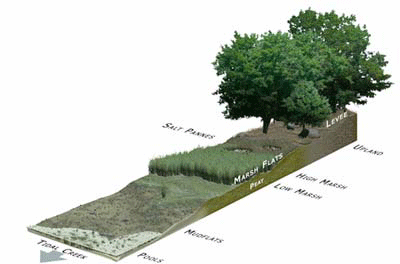Estuaries Dominant Plants
The release of DOM from emergent and submerged macrophytes occurs predominantly after senescence of plant material commences whereas living phytoplankton and other microalgae in estuaries contribute soluble substances to the water body. They are transition zones between river and sea and provide critical habitat for an assortment of plants and animals.

Pennsylvania Students And Chincoteague Bay Field Station Team Up To Monitor Restore Coastal Ecosystem Ecosystems Costal Shippensburg University Source: br.pinterest.com
Dominant Plants The dominant plant types of estuaries are sea grass Zostera capricorni sea rush Juncus kraussii and jointed rush also known as oioi Apodasmia Simillis.

Estuaries dominant plants. The classification of J. However estuaries are critical habitat for certain wild animals at some stage of their lives. The most common plants seen in estuaries are the common reedswitchgrass salt marsh cordgrass American glass wortin estuaries.
Many types of animals are found in estuaries. River input sets up seaward net flow that carries sediment and other materials and organisms out of the estuary. Habitat for Wildlife 4 Animals in Estuaries Few animals can live their entire lives in estuaries.
The most common plants seen in estuaries are the common reedswitchgrass salt marsh cordgrass American glass wortin estuaries found in America. More than 70 percent of Georgias recreationally and commercially important fishes crustaceans and shellfish spend at least part of their lives in estuaries. This facilitates the thriving of a unique.
Salicornia maritima a type of succulent plant commonly referred to as pickleweed from Elkhorn Slough National Estuarine Research Reserve. The few estuarine animal species that have adapted to the characteristically changeable conditions of salinity temperature and water level. In estuaries with substantial river input freshwater flow is a dominant control on physical conditions.
Estuaries facilitate the development of various land forms at the coast such as bays lagoons harbors inlets and fjords. Examples include oyster drills Chinese mitten crabs and Brazilian pepper trees. The fact that salt dominates the estuary biome means that most plants cannot survive in that environment.
Estuaries where freshwater mixes with saltwater are dominant and vital ecosystems along Georgias coast. Estuaries themselves may be classified according to various parameters such as tidal range hydrology dominant process or mode of origin. What are the dominant plants in an estuary.
Destroy the surrounding habitat. Freshwater mixes with ocean water producing a horizontal. Estuaries are usually rich in nutrients due to the mix of fresh and salty waters.
However estuaries respond differently to variations in river flow depending on bathymetry tidal currents and wind. A flock of birds in the water at the Elkhorn Slough Reserve in California. In fact the complex food web found in an estuary helps to support an amazing diversity of animals.
Salmon have adapted to saltwater and freshwater so that they can live in the sea and then swim out of it into the river to have their young. Davies of Australia that is based on tidal range can be applied to estuaries as discussed by Miles. 4 Plants in estuaries.
In almost all estuaries the salinity of the water changes constantly over the tidal cycle. Mangrove trees and blue crabs are some of the estuarine species that have adapted to unique environmental conditions. This can drive out â nativeâ.
An estuary is a partly concealed body of water where fresh water from rivers and canals mixes with the salty and brackish waters of the open sea. The decaying plants are eaten by microorganisms animals so tiny you need a microscope to see them The microorganisms are eaten by small invertebrates animals without backbones Fish like carp. Photo courtesy Lake Superior National Estuarine Research Reserve.
Birds are also abundant in estuaries. This can drive out native plants and animals. Estuaries and the lands surrounding them are places of transition from land to sea and freshwater to salt water.
Seashore saltgrass and herbaceous plants Estuary MarshBlue listed This rare estuary marshland is dominated by seashore saltgrass Distichlis spicata with few other plants tol- erant of the salinity from frequent tidal floodings.

Plant Dominant Chaparral Flora Chaparral Plants Scenery Source: www.pinterest.com

Http Www Ecossistemas Com Trailer Park Island On Wheels Installation Art Source: www.pinterest.com

Pin On Biomes Source: www.pinterest.com

Estuarine Habitats Estuaries Tutorial Source: oceanservice.noaa.gov

River Bank Landscaping How To Choose Plants Suitable For River Banks Source: www.gardeningknowhow.com

The Forest Is An Area Of Bogs With A Very Specific Group Of Plants That Can Live Is This Acidic Soil Strunted Shore Pines Ar Simon Nessman Island Park Ocean Source: www.pinterest.com
